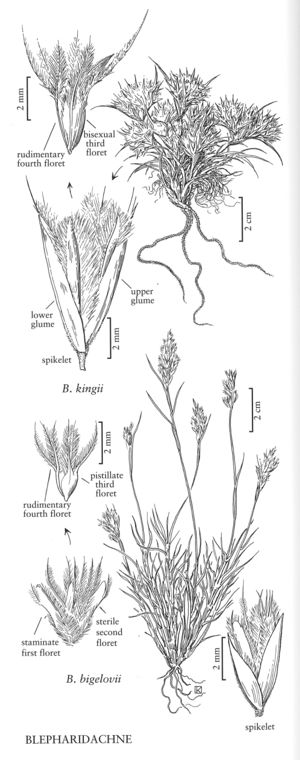Difference between revisions of "Blepharidachne bigelovii"
FNA>Volume Importer |
FNA>Volume Importer |
(No difference)
| |
Revision as of 19:24, 24 September 2019
Plants cespitose, from a firm, often knotty base. Culms 6-20 cm, freely branched at and above the bases. Sheaths usually with a tuft of hairs on either side of the collars, often puberulent on the backs; ligules to 0.3 mm; blades 1-2 cm long, less than 1 mm wide, involute, convolute to conduplicate, firm, harshly puberulent, stiffly arcuate, lower blades deciduous. Panicles 15-30 mm long, 10-15 mm wide, exserted or partially included in the upper 2, subopposite, subtending sheaths; rachises and branches puberulent. Spikelets 5-7 mm. Glumes nearly equal to the lowest lemmas in the spikelets, exceeded by the distal florets, thin, translucent, smooth or the vein scabridulous, subacute; lower glumes 5-6 mm; upper glumes about 6 mm; lowest florets staminate, 4-5 mm; second florets sterile, about 5 mm, lateral lobes 1-3 mm; paleas of lowest 2 florets reduced, membranous; third florets pistillate, third lemmas 5.5-6 mm, lateral lobes 3-4.5 mm, awned, central awns 2.5-3 mm; paleas of third florets slightly longer than the lemmas; anthers 2(1), 1.2-1.5 mm. Caryopses 1.5-2 mm. 2n = 14.
Discussion
Blepharidachne bieglovii grows on rocky slopes in western Texas and adjacent areas of New Mexico, and Coahuila and Zacatecas, Mexico.
Selected References
None.
